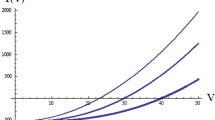Abstract
The theory of the longitudinal (with respect to an external magnetic field) response of a combined spin system of localized paramagnetic centers (s subsystem) and free charge carriers (e subsystem) of a solid semiconductor to modulated saturation of EPR is developed. In contrast to relevant studies made earlier, the general case is considered of an arbitrary modulation frequency and arbitrary detuning of the saturating microwave field with respect to the central EPR frequency. A theoretical approach is used in which normal modes are considered in analyzing coupled oscillations of the spin magnetizations of the s and e subsystems. It is shown that, in the case of relaxation coupling between the subsystems, the longitudinal response recorded at the modulation frequency can be represented as the sum of the responses of the normal modes, each of which is described by a universal resonance lineshape that is different, in general, from the Lorentzian lineshape characteristic of EPR signals. In the extreme cases of weak and strong coupling, simple analytical formulas are derived. The results presented form a theoretical basis for applying the method of modulated longitudinal response for measuring very short longitudinal spin relaxation times in semiconductors with paramagnetic impurities. As an example, experimental data are presented for activated carbon containing stable free radicals.
Similar content being viewed by others
References
J. Herve and J. Pescia, C. R. Acad. Sci. 251, 665 (1960).
J. Herve, in Proceedings of 1st International Conference on Paramagnetic Resonance, Ed. by W. Low (Academic, New York, 1963), p. 689.
J. Pescia, Ann. Phys. (Paris) 10, 389 (1965).
V. A. Atsarkin, G. A. Vasneva, and V. V. Demidov, Zh. Éksp. Teor. Fiz. 108(3), 927 (1995) [JETP 81, 509 (1995)]; Phys. Rev. B 52, 1290 (1995).
V. A. Atsarkin, V. V. Demidov, and G. A. Vasneva, Phys. Rev. B 56(15), 9448 (1997).
V. A. Atsarkin and V. V. Demidov, Zh. Éksp. Teor. Fiz. 113(3), 1048 (1998) [JETP 86, 572 (1998)].
V. A. Atsarkin, V. V. Demidov, G. A. Vasneva, and V. K. Conder, Phys. Rev. B 63, 092405 (2001).
N. P. Fokina and K. O. Khutsishvili, Appl. Magn. Res. 17, 503 (1999).
N. P. Fokina and K. O. Khutsishvili, Zh. Éksp. Teor. Fiz. 123(1), 98 (2003) [JETP 96, 83 (2003)].
G. Ablart and J. Pescia, Phys. Rev. B 22(3), 1150 (1980).
S. E. Barnes, Adv. Phys. 30(6), 801 (1981).
M. B. Walker, Phys. Rev. B 7(7), 2920 (1973).
I. N. Bronshtein and K. A. Semendyaev, Handbook on Mathematics (Nauka, Moscow, 1981), p. 559.
V. V. Migulin, V. I. Medvedev, E. R. Mustel’, and V. N. Parygin, Foundations of the Oscillation Theory (Nauka, Moscow, 1978), p. 245.
L. R. Tagirov and K. F. Trutnev, Zh. Éksp. Teor. Fiz. 86(3), 1092 (1984) [Sov. Phys. JETP 59, 638 (1984)].
L. L. Buishvili, M. D. Zviadadze, and G. R. Khutsishvili, Zh. Éksp. Teor. Fiz. 56(1), 290 (1969) [Sov. Phys. JETP 29, 159 (1969)].
V. A. Atsarkin, Zh. Éksp. Teor. Fiz. 56(3), 769 (1970).
V. A. Atsarkin, V. V. Demidov, G. A. Vasneva, et al., J. Magn. Reson. 149, 85 (2001).
Author information
Authors and Affiliations
Additional information
__________
Translated from Fizika Tverdogo Tela, Vol. 45, No. 11, 2003, pp. 1921–1927.
Original Russian Text Copyright © 2003 by Fokina, Élizbarashvili, Atsarkin, Demidov.
Rights and permissions
About this article
Cite this article
Fokina, N.P., Élizbarashvili, M.O., Atsarkin, V.A. et al. Longitudinal response of the spin system of a metal to modulated EPR saturation at arbitrary modulation frequency and detuning of the saturating field. Phys. Solid State 45, 2017–2024 (2003). https://doi.org/10.1134/1.1626731
Received:
Issue Date:
DOI: https://doi.org/10.1134/1.1626731




